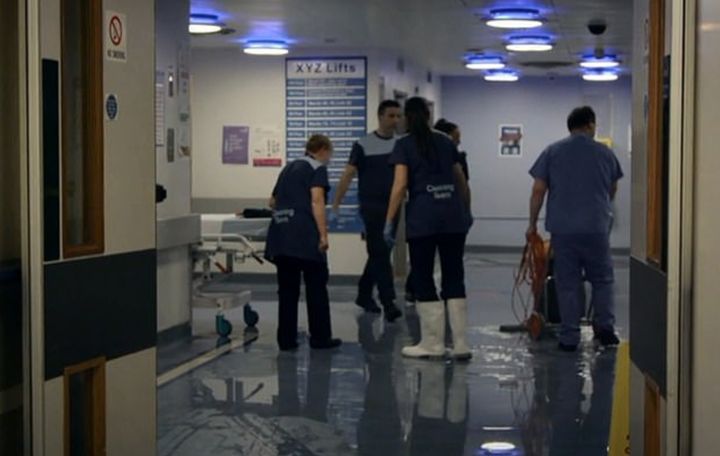Hundreds of NHS patients face being treated on potentially unsafe wards for years longer than planned, as health chiefs spend millions coping with the fallout from the collapse of construction giant Carillion, HuffPost UK has found.
In the year since the firm’s demise, staff and patients at City Hospital in Birmingham – which was due to be partly replaced last year by a Carillion-built development – have been forced to cope with inadequate facilities. Some of these carried “significant” risks, an NHS report said.
Many services at City and the nearby Sandwell hospital were due to be moved to the Midland Metropolitan, a £350million mega hospital at Smethwick, in the West Midlands, by October 2018.
But despite concerns over existing facilities, the new site remains effectively frozen in time. Fresh bids to finish its construction are still out to tender, and its opening has been pushed back by at least four years.
Bosses at the Sandwell and West Birmingham NHS Trust, which operates City and is leading the development of Midland Met, have conceded they must now spend £250m more than planned on finishing the new project and ensuring existing wards are safe.

Carillion earned around £205m from the Midland Met project before the firm collapsed. But since the firm’s demise, total costs for the project are estimated to have soared by a further £400m to £605m, with the government picking up the tab.
Part of the huge sum will be spent on repairing ageing wards and clinics at City Hospital which were expected to be closed to patients much earlier than the new 2022 deadline.
The fallout from Carillion’s collapse within the health service also exposed the extent of its reliance on private firms, a doctors’ trade union said, as new figures show outsourcing across the public sector rose by 53% last year.
The British Medical Association (BMA) said the delays and costs incurred following Carillion’s collapse risk “destabilising” services and dragging down staff morale.
“The wildcard of suddenly being told that there will be an increase in expenditure just de-stabilises services and results in service cuts that impact doctors, nurses and patients,” the chair of the BMA, Dr Chaand Nagpaul, said.
“When there are delays, it demoralises staff and more importantly it means doctors, nurses, and patients are unable to be treated within the facilities that they need,” he added.
“The reason these projects are approved is because there is a need to provide them. If there is then years of delay it means patients are going to continue suffering with inadequate space and facilities. That is demoralising and also affects the treatment of patients.”
Similar issues at the Royal Liverpool Hospital in Merseyside were exposed last week by the BBC’s ‘Hospital’ programme, which showed older buildings had flooded 10 times last year, while a new Carillion-built hospital stood empty next door.

Figures showed 79% of the existing Royal Liverpool’s floor space was “not functionally suitable” – affecting 39% of patient space, such as wards.
Health bosses said they expect the cost of restoring the 1970s building to be at least £3m, despite the brand-new £315m development being relatively near completion when Carillion collapsed. Work to finish off the new building re-commenced late last year.
And a year on from Carillion’s insolvency, HuffPost UK also found:
- Thousands of Carillion’s employees were made redundant – including young apprentices – despite Whitehall mobilising rapid response teams and spending millions to prevent mass job losses;
- Dozens of suppliers were sent to the wall by the firm’s demise – with other small businesses brought to the brink after contracts went unsettled – prompting many to change the way they do business;
- Carillion’s complex structure has confronted the government’s Insolvency Service with what sources said was its biggest task in a generation, as it battles to untangle the mess left behind;
- And the official receiver, a civil servant appointed to assess what happened at Carillion, is under pressure to publish a report and rule whether the firm’s directors should be disqualified from future leadership roles.
Thousands jobless
Figures shared with HuffPost UK this week by the Insolvency Service showed there were 3,038 total redundancies at Carillion, some 16.6% of staff.
Some 1,274 employees left the business during the liquidation through finding new work, retirement or for other reasons.
Among those who left employment were 312 apprentices, who were studying for construction qualifications at the time the company closed down.
Despite the job losses, a total of 13,945 workers, 76.4%, have been transferred to new suppliers.
Suppliers lose out
Meanwhile, the knock-on effect on Carillion’s suppliers saw dozens of firms close down as contracts went unpaid, while others were brought to the brink.
Contractors including roofers, tilers, painters, carpenters and electricians were affected when Carillion went bust, with many owed hundreds of thousands by the firm. There is now little hope the small businesses will ever see the money they are owed.
“The ripples from the Carillion situation have spread far and wide,” Helen Wheeler, of financial services firm Bibby, which helps smaller suppliers manage payments from big firms like Carillion, said.
“We had one client with a relatively small business who lost £800,000 because of the demise of Carillion. That was what was owed to him. Quite how he has managed to trade through, I don’t know. He has had to sell everything, but he has continued and he will build his business back up again,” she added.
“We do know businesses that have completely failed because of Carillion. A few of them were our clients however a few clients we did manage to help out, to try and smooth out the ride for them going forward.”
Wheeler added that the government’s support for Carillion in its final months, such as the award of £1.3bn worth of contracts after its first profit warning, has sowed deep mistrust between it and small businesses.
“There’s also a lot of mistrust toward the government because of Carillion. As much as the profit warnings kept coming out and other signs, the government was still backing Carillion. So suppliers thought, ‘I’ll invest my money in it too’. A lot of them feel let down by that.”
Mike Cherry, chairman of the Federation of Small Businesses, said: “The collapse of Carillion was a watershed moment that brutally exposed the shocking ways that some big businesses treat their suppliers.
“The construction giant used its dominant position to squeeze smaller firms with late payments and unreasonable payment terms in an attempt to shore up its own precarious position.”
Receiver under pressure
The chaos at Carillion and what led to its insolvency is now subject to an investigation by the official receiver, a Whitehall civil servant who was appointed in the wake of the collapse to handle the transfer of Carillion’s public contracts and probe what went wrong.
They have come under renewed pressure from ministers to “expedite” their report – which will include an opinion on whether Carillion’s directors should face disqualification from senior business roles in future.
The Business Secretary Greg Clark ordered officials to hasten their probe into the collapse last month.
One source said Carillion’s failure has come to dominate the Insolvency Service’s offices in Whitehall, with entire walls used to illustrate the company’s confusing web of associated companies, some of which did not even carry Carillion’s name.
Carillion’s structure is believed to be one of the inspirations for a recent consultation by the government on tightening rules around corporate governance.
The consultation, which closed to submissions in August, proposed greater accountability for directors of parent companies which attempt to sell subsidiary firms to raise cash.
A spokesperson for the official receiver said this week: “Secure, ongoing employment was found for more than three quarters of Carillion’s workforce when their roles transferred to new suppliers.
“Our investigation into the causes of Carillion’s collapse is ongoing.”
Toby Lewis, chief executive of Sandwell and West Birmingham NHS Trust, said the organisation had secured £400m from the government to finish off Midland Met and pay for “any necessary interim service changes and maintenance of our current hospital buildings for longer than we expected due to the delay”.
He added: “We continually risk assess our facilities to ensure they are fit for purpose and currently have no outstanding backlog issues categorised as high risk. We schedule works to deal with low and medium risk in order of priority.
“Following Carillion’s collapse in January last year, we worked to secure arrangements to complete the build and announced the government had granted public finance for the construction costs in August last year.
“Construction company Balfour Beatty began remedial work on site in October, and, following submissions on the tender to complete the building, we expect to award the contract this summer, with the new hospital ready to open in 2022.”
A government spokesperson said: “This government has taken great strides to improve how we work with the private sector, including requiring companies to demonstrate prompt payment to suppliers and piloting ‘living wills’ for critical contracts, allowing contingency plans to be quickly put into place if needed.”
